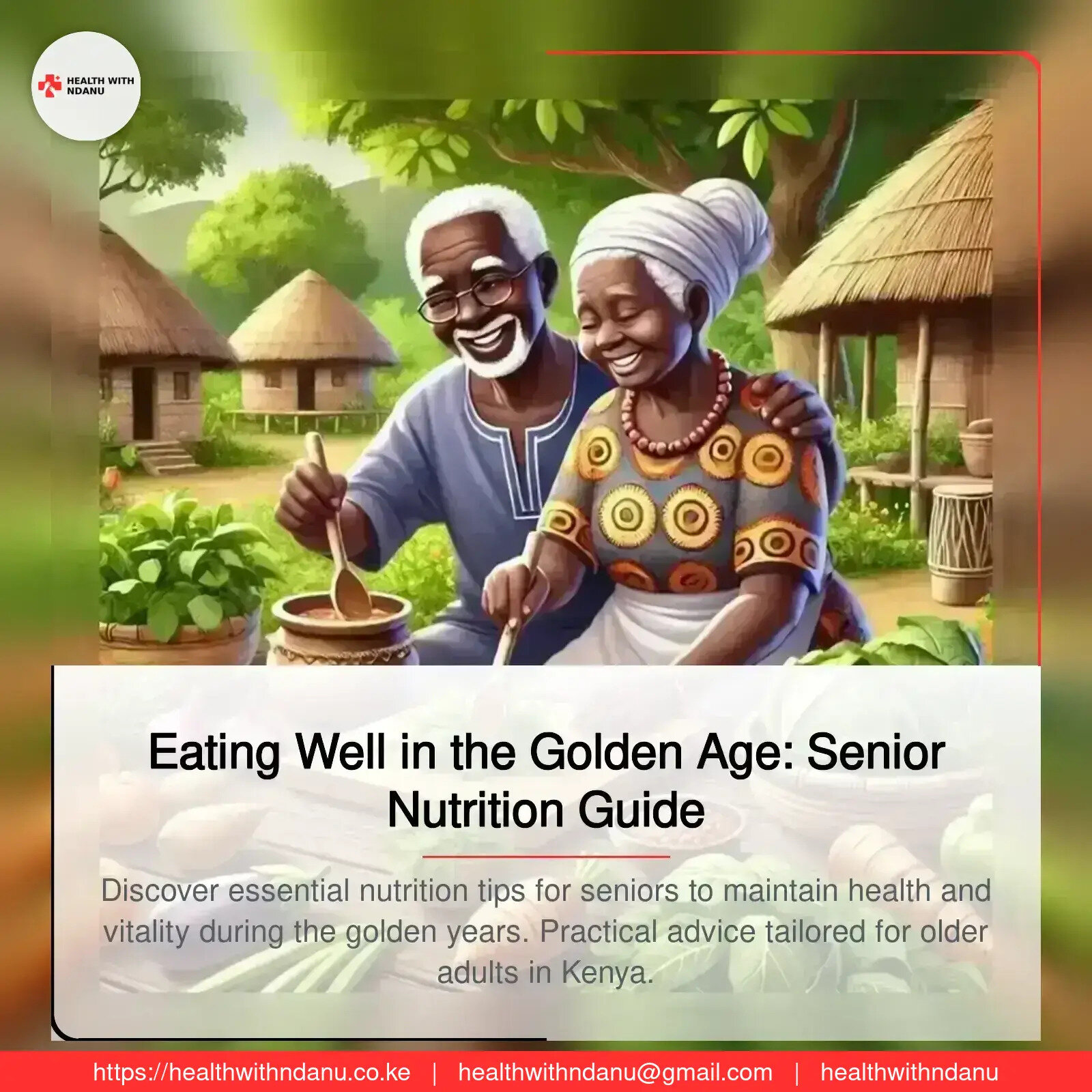Eating Well in the Golden Age: Senior Nutrition Guide
- by Diana Ndanu
- 18 January, 2025
- 0 Comments
- 6 Mins



Introduction
Aging is a beautiful journey, but as we grow older, our nutritional needs evolve. The body undergoes changes that require more attention to what we eat, making nutrition for older adults a cornerstone of healthy aging. Whether you're an older adult or a caregiver, understanding the importance of a balanced diet can help maintain energy, boost immunity, and improve overall quality of life.
In this article, we’ll explore the unique nutritional needs of older adults, common challenges they face, and practical tips to ensure a well-rounded diet.
Why Nutrition Matters More Than Ever as We Age
As we age, our metabolism slows down, muscle mass declines, and the body becomes less efficient at absorbing nutrients. This makes it crucial to focus on nutrient-dense foods to:
- Maintain physical and mental health.
- Prevent or manage chronic illnesses like diabetes, hypertension, and osteoporosis.
- Boost energy levels and overall vitality.
Key Nutritional Needs for Older Adults
1. Protein: The Building Block of Life
Protein helps maintain muscle mass, repair tissues, and support the immune system. Unfortunately, many older adults don’t get enough protein.
Sources of Protein:
- Lean meats like chicken and turkey.
- Fish rich in omega-3s, such as salmon and mackerel.
- Plant-based options like lentils, beans, and tofu.
- Dairy products like yogurt and cheese.
Pro Tip: Aim for 1-1.2 grams of protein per kilogram of body weight daily.
2. Calcium and Vitamin D: Strong Bones, Strong Life
Bone density decreases with age, increasing the risk of fractures. Calcium and Vitamin D are essential for bone health.
Sources of Calcium:
- Dairy products: Milk, cheese, yogurt.
- Leafy greens: Kale, spinach, and broccoli.
- Fortified foods: Orange juice and cereals.
Sources of Vitamin D:
- Fatty fish like tuna and sardines.
- Egg yolks.
- Sun exposure (15-20 minutes daily).
Pro Tip: Consider supplements if dietary intake is insufficient, but consult your doctor first.
3. Fiber: For a Healthy Gut
Fiber aids digestion, prevents constipation, and reduces the risk of heart disease.
High-Fiber Foods:
- Whole grains: Oats, brown rice, and whole wheat bread.
- Fruits: Apples, pears, and berries.
- Vegetables: Carrots, sweet potatoes, and green beans.
- Legumes: Lentils, chickpeas, and black beans.
Pro Tip: Drink plenty of water when increasing fiber intake to avoid digestive discomfort.
4. Healthy Fats: For Heart and Brain Health
Not all fats are bad! Healthy fats are essential for brain function and cardiovascular health.
Healthy Fat Sources:
- Avocados and olive oil.
- Nuts and seeds like almonds, walnuts, and flaxseeds.
- Fatty fish rich in omega-3s.
Pro Tip: Limit saturated and trans fats found in fried foods and processed snacks.
5. Hydration: The Overlooked Essential
Dehydration is common in older adults due to a reduced sense of thirst. Staying hydrated is vital for digestion, temperature regulation, and joint health.
Tips to Stay Hydrated:
- Drink 6-8 cups of water daily.
- Include hydrating foods like cucumbers, watermelon, and soups.
- Limit caffeine and alcohol, which can dehydrate the body.
6. Vitamins and Minerals: The Micronutrient Boost
- Vitamin B12: Supports nerve function and red blood cell production. Sources include eggs, fish, and fortified cereals.
- Magnesium: Maintains muscle and nerve function. Found in nuts, seeds, and whole grains.
- Potassium: Helps regulate blood pressure. Found in bananas, oranges, and potatoes.
Pro Tip: A multivitamin tailored for older adults can fill nutritional gaps.
Common Nutritional Challenges for Older Adults
1. Loss of Appetite: This can result from medication side effects, reduced activity, or changes in taste and smell.
Solution: Eat smaller, nutrient-rich meals more frequently.
2. Difficulty Chewing or Swallowing: Dental issues or medical conditions may make eating harder.
Solution: Choose softer foods like mashed vegetables, yogurt, and smoothies.
3. Chronic Conditions: Diseases like diabetes or heart disease can restrict dietary choices.
Solution: Work with a dietitian to create a tailored meal plan
4. Social Isolation: Eating alone can lead to skipped meals or poor food choices.
Solution: Share meals with family or join community dining programs.
5. Financial Constraints: Fixed incomes can limit access to fresh and healthy foods.
Solution: Look for affordable options like frozen vegetables and community food assistance programs.
Practical Tips for Healthy Eating
1.Plan Balanced Meals
A well-balanced plate should include:
- Half fruits and vegetables.
- A quarter lean protein.
- A quarter whole grains.
- Prepare Meals in Advance
Cooking in bulk and freezing meals can save time and ensure access to healthy options.
2.Limit Processed Foods
Avoid foods high in salt, sugar, and unhealthy fats. Instead, opt for homemade meals and snacks.
3.Use Herbs and Spices
Enhance the flavor of meals with herbs and spices instead of salt.
4.Make Eating Enjoyable.
Present nice spoons and plates,all needed cutlery should be clean and dry. Keep away broken,torn,leaking utensils.
5.Experiment with new recipes.
Try new recipes, avoid the obvious meals and being predictable.
6.Dine with friends or family.
Invite friends or close family members to dine with you. Meals are more delicious when you have company.
7.Use colorful and appetizing food presentations.
Use colourful cutlery, a colourful food may tempt one to eat since it's attractive to the eye and looks yummy.
Easy and Healthy Meal Ideas for Older Adults
1. Breakfast: Oatmeal topped with fresh berries and a drizzle of honey.
2. Lunch: Grilled chicken salad with mixed greens, cherry tomatoes, and olive oil dressing.
3. Snack: A handful of almonds and an apple.
4. Dinner: Baked salmon with quinoa and steamed broccoli.
5. Dessert: Greek yogurt with a sprinkle of cinnamon and a few walnuts.
The Role of Exercise in Nutrition
Pairing good nutrition with regular exercise enhances the benefits of both. Exercise boosts metabolism, improves appetite, and helps maintain muscle mass. Older adults should aim for 150 minutes of moderate-intensity exercise weekly, including activities like walking, swimming, or yoga.
When to Seek Professional Advice
If you or a loved one struggle with nutritional issues, consult a healthcare provider or dietitian. They can offer personalized advice, recommend supplements, and address specific health concerns.
Conclusion: Nourish Your Body, Enrich Your Life
Good nutrition is the cornerstone of healthy aging. By focusing on nutrient-dense foods, staying hydrated, and addressing unique challenges, older adults can enjoy a vibrant and fulfilling life.
Remember, it’s never too late to make positive changes. Start small, stay consistent, and celebrate the journey to better health—one nutritious meal at a time!
The Role of Physical Activity
Incorporate regular, moderate exercise such as walking, gardening, or traditional dances to maintain muscle mass, balance, and overall well-being.
Community and Family Support
Engage in community programs focused on senior health, and encourage family involvement in meal preparation and shared dining experiences.
Conclusion
Eating well in the golden age is not just about nutrition; it's about enhancing quality of life, maintaining independence, and enjoying the richness of our later years. By understanding and adapting to the unique nutritional needs of older adults, we can promote health and vitality well into our senior years.
Got Your Own Experience? Share with us
Kategoria Maarufu
Blogu Zinazotembelewa Zaidi
Daily Newsletter
Get all the top stories from Blogs to keep track.



